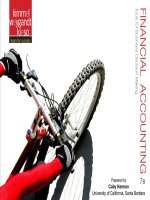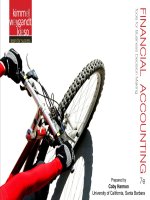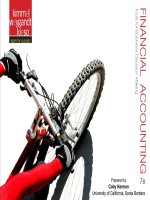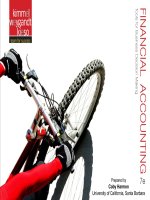Financial accounting 7e harmon chapter 09 reporting and analyzing long live assets
Bạn đang xem bản rút gọn của tài liệu. Xem và tải ngay bản đầy đủ của tài liệu tại đây (1.89 MB, 81 trang )
9-1
REPORTING AND
ANALYZING
LONG-LIVED
ASSETS
9-2
Financial Accounting, Seventh Edition
9
Learning
Learning Objectives
Objectives
After studying this chapter, you should be able to:
9-3
1.
Describe how the historical cost principle applies to plant assets.
2.
Explain the concept of depreciation.
3.
Compute periodic depreciation using the straight-line method, and contrast
its expense pattern with those of other methods.
4.
Describe the procedure for revising periodic depreciation.
5.
Explain how to account for the disposal of plant assets.
6.
Describe methods for evaluating the use of plant assets.
7.
Identify the basic issues related to reporting intangible assets.
8.
Indicate how long-lived assets are reported in the financial statements.
Preview of Chapter 9
9-4
Financial Accounting
Seventh Edition
Kimmel Weygandt Kieso
Plant
Plant Assets
Assets
Plant assets are resources that have
physical substance (a definite size and shape),
are used in the operations of a business,
are not intended for sale to customers,
are expected to provide service to the company for a number
of years, except for land.
Referred to as property, plant, and equipment; plant and
equipment; and fixed assets.
9-5
LO 1 Describe how the historical cost principle applies to plant assets.
Plant
Plant Assets
Assets
Plant assets are critical to a company’s success
Illustration 9-1
9-6
LO 1 Describe how the historical cost principle applies to plant assets.
Determining
Determining the
the Cost
Cost of
of Plant
Plant Assets
Assets
Historical Cost Principle - requires that companies
record plant assets at cost.
Cost consists of all expenditures necessary to acquire an
asset and make it ready for its intended use.
Revenue expenditure – costs incurred to acquire a plant
asset that are expensed immediately.
Capital expenditures - costs included in a plant asset
account.
9-7
LO 1 Describe how the historical cost principle applies to plant assets.
Determining
Determining the
the Cost
Cost of
of Plant
Plant Assets
Assets
Cost - cash paid in a cash transaction or the cash equivalent
price paid.
Cash equivalent price is the
fair value of the asset given up or
fair value of the asset received,
whichever is more clearly determinable.
9-8
International Note
IFRS is flexible
regarding asset
valuation.
Companies revalue
to fair value when
they believe this
information is more
relevant.
LO 1 Describe how the historical cost principle applies to plant assets.
Determining
Determining the
the Cost
Cost of
of Plant
Plant Assets
Assets
Land
All necessary costs incurred in making land ready for its
intended use increase (debit) the Land account.
Costs typically include:
1) cash purchase price,
2) closing costs such as title and attorney’s fees,
3) real estate brokers’ commissions, and
4) accrued property taxes and other liens on the land
assumed by the purchaser.
9-9
LO 1 Describe how the historical cost principle applies to plant assets.
Determining
Determining the
the Cost
Cost of
of Plant
Plant Assets
Assets
Illustration: Assume that Hayes Manufacturing Company
acquires real estate at a cash cost of $100,000. The property
contains an old warehouse that is razed at a net cost of $6,000
($7,500 in costs less $1,500 proceeds from salvaged materials).
Additional expenditures are the attorney’s fee, $1,000, and the
real estate broker’s commission, $8,000.
Required: Determine the amount to be reported as the cost of
the land.
9-10
LO 1 Describe how the historical cost principle applies to plant assets.
Determining
Determining the
the Cost
Cost of
of Plant
Plant Assets
Assets
Required: Determine amount to be reported as the cost of the land.
Land
Cash price of property ($100,000)
Net removal cost of warehouse ($6,000)
6,000
Attorney's fees ($1,000)
1,000
Real estate broker’s commission ($8,000)
8,000
Cost of Land
9-11
$100,000
$115,000
LO 1 Describe how the historical cost principle applies to plant assets.
Determining
Determining the
the Cost
Cost of
of Plant
Plant Assets
Assets
Land Improvements
Includes all expenditures necessary to make the
improvements ready for their intended use.
9-12
Examples: driveways, parking lots, fences, landscaping,
and underground sprinklers.
Limited useful lives.
Expense (depreciate) the cost of land improvements over
their useful lives.
LO 1 Describe how the historical cost principle applies to plant assets.
Determining
Determining the
the Cost
Cost of
of Plant
Plant Assets
Assets
Buildings
Includes all costs related directly to purchase or construction.
Purchase costs:
Purchase price, closing costs (attorney’s fees, title insurance,
etc.) and real estate broker’s commission.
Remodeling and replacing or repairing the roof, floors,
electrical wiring, and plumbing.
Construction costs:
9-13
Contract price plus payments for architects’ fees, building
permits, and excavation costs.
LO 1 Describe how the historical cost principle applies to plant assets.
Determining
Determining the
the Cost
Cost of
of Plant
Plant Assets
Assets
Equipment
Include all costs incurred in acquiring the equipment and
preparing it for use.
Costs typically include:
9-14
Cash purchase price.
Sales taxes.
Freight charges.
Insurance during transit paid by the purchaser.
Expenditures required in assembling, installing, and testing
the unit.
LO 1 Describe how the historical cost principle applies to plant assets.
Determining
Determining the
the Cost
Cost of
of Plant
Plant Assets
Assets
Illustration: Lenard Company purchases a delivery truck at a
cash price of $22,000. Related expenditures are sales taxes
$1,320, painting and lettering $500, motor vehicle license $80, and
a three-year accident insurance policy $1,600. Compute the cost
of the delivery truck.
Truck
Cash price
$22,000
Sales taxes
1,320
Painting and lettering
Cost of Delivery Truck
9-15
500
$23,820
LO 1 Describe how the historical cost principle applies to plant assets.
Determining
Determining the
the Cost
Cost of
of Plant
Plant Assets
Assets
Illustration: Lenard Company purchases a delivery truck at a cash
price of $22,000. Related expenditures are sales taxes $1,320,
painting and lettering $500, motor vehicle license $80, and a threeyear accident insurance policy $1,600. Prepare the journal entry
to record these costs.
Equipment
23,820
License expense
80
Prepaid insurance
1,600
Cash
25,500
9-16
LO 1 Describe how the historical cost principle applies to plant assets.
Determining
Determining the
the Cost
Cost of
of Plant
Plant Assets
Assets
To Buy or Lease?
A lease is a contractual agreement in which the owner of an
asset (lessor) allows another party (lessee) to use the asset
for a period of time at an agreed price.
Some advantages of leasing
1. Reduced risk of obsolescence.
2. Little or no down payment.
3. Shared tax advantages.
4. Assets and liabilities not reported.
Capital lease - lessees show the asset and liability on the balance sheet.
9-17
LO 1 Describe how the historical cost principle applies to plant assets.
9-18
Accounting
Accounting for
for Plant
Plant Assets
Assets
Depreciation
Process of allocating to expense the cost of a plant asset over
its useful (service) life in a rational and systematic manner.
9-19
Process of cost allocation, not asset
valuation.
Applies to land improvements, buildings,
and equipment, not land.
Depreciable, because the revenueproducing ability of asset will decline
over the asset’s useful life.
Helpful Hints
Land does not
depreciate because it
does not wear out.
Depreciation expense is
reported on the income
statement. Accumulated
depreciation is reported
on the balance sheet.
LO 2 Explain the concept of depreciation.
Accounting
Accounting for
for Plant
Plant Assets
Assets
Factors in Computing Depreciation
Illustration 9-6
Cost
9-20
Useful Life
Salvage Value
LO 2 Explain the concept of depreciation.
Accounting
Accounting for
for Plant
Plant Assets
Assets
Depreciation Methods
Management selects the method it believes best measures an
asset’s contribution to revenue over its useful life.
Examples include:
(1) Straight-line method.
(2) Declining-balance method.
(3) Units-of-activity method.
Illustration 9-7
Use of depreciation
methods in major U.S.
companies
9-21
LO 3
Accounting
Accounting for
for Plant
Plant Assets
Assets
Illustration: Bill’s Pizzas purchased a small delivery truck on
January 1, 2012.
Cost
$13,000
Expected salvage value
$1,000
Estimated useful life (in years)
5
Estimated useful life (in miles)
100,000
Required: Compute depreciation using the following.
(a) Straight-Line. (b) Units-of-Activity. (c) Declining-Balance.
9-22
LO 3 Compute periodic depreciation using the straight-line method,
and contrast its expense pattern with those of other methods.
Accounting
Accounting for
for Plant
Plant Assets
Assets
Straight-Line
Expense is same amount for each year.
Depreciable cost = Cost less salvage value.
Illustration 9-8
9-23
LO 3 Compute periodic depreciation using the straight-line method,
and contrast its expense pattern with those of other methods.
Accounting
Accounting for
for Plant
Plant Assets
Assets
Illustration: (Straight-Line Method)
2014
$ 12,000
2015
12,000
2016
12,000
2017
12,000
2018
12,000
20%
Illustration 9-9
$ 2,400
$ 2,400
$ 10,600
2,400
4,800
8,200
2,400
7,200
5,800
2,400
9,600
3,400
2,400
12,000
1,000
20
20
20
20
2014
Journal
Entry
9-24
Depreciation expense
2,400
Accumulated depreciation
2,400
LO 3 Compute periodic depreciation using the straight-line method,
and contrast its expense pattern with those of other methods.
Accounting
Accounting for
for Plant
Plant Assets
Assets
Partial
Year
Illustration: (Straight-Line Method)
Assume the delivery truck was purchased on April 1, 2014.
9-25
LO 3









